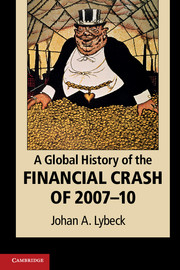Book contents
- Frontmatter
- Contents
- List of figures
- List of tables
- Preface
- Acknowledgments
- Abbreviations
- 1 Introduction
- 2 Financial crises in the USA and Europe, but not in Asia
- 3 Could today’s financial crisis have been foreseen?
- 4 The US housing market and the subprime crisis
- 5 Securitization and derivatives spread the crisis around the world
- 6 Liquidity risk aspects of the crisis and a comparison with 1907 and 1929
- 7 Credit risk aspects of the crisis, rating and solvency
- 8 Financial crises in modern history
- 9 Worldwide changes in regulation and supervision as a result of the crisis
- 10 Outstanding issues
- Bibliography
- Index
2 - Financial crises in the USA and Europe, but not in Asia
Published online by Cambridge University Press: 05 June 2012
- Frontmatter
- Contents
- List of figures
- List of tables
- Preface
- Acknowledgments
- Abbreviations
- 1 Introduction
- 2 Financial crises in the USA and Europe, but not in Asia
- 3 Could today’s financial crisis have been foreseen?
- 4 The US housing market and the subprime crisis
- 5 Securitization and derivatives spread the crisis around the world
- 6 Liquidity risk aspects of the crisis and a comparison with 1907 and 1929
- 7 Credit risk aspects of the crisis, rating and solvency
- 8 Financial crises in modern history
- 9 Worldwide changes in regulation and supervision as a result of the crisis
- 10 Outstanding issues
- Bibliography
- Index
Summary
Origins of the crises
A financial crisis is, by definition, unexpected. If it were anticipated, it would not occur. There will appear a sudden flare of fire, even though there might have been some smoke visible before. Today’s financial crisis, the worst in 80 years, had been smoldering since the end of 2006. But “the firemen” had been on guard and prevented the flames from blazing forth. The central banks, guided by the actions of the Federal Reserve, had lowered their target interest rates in order to enable banks to lower their lending rates in turn, in particular with regard to housing. They had also injected gradually larger amounts of liquidity into the system. The Fed Funds rate, which is the major monetary policy weapon of the US central bank, was 5.25 percent in the beginning of 2007. Two years later it had been lowered to basically zero (and in the autumn of 2010, that is where it still is). This is the lowest central bank lending rate recorded over the 95 years that the central bank has existed (for the “Fed” was actually only founded in 1913, after the great crisis of 1907). Other major central banks, such as the Bank of England and the European Central Bank (ECB), were only paces behind.
In a smoothly functioning economy, banks lend to one another in the interbank market. These loans are extremely short-term, most often just for a day (or rather for a night), evening out liquidity imbalances in the system. A bank with excess reserves lends money to a bank that is short on cash. So long as the banks regard one another as being perfectly safe, the interbank rate will lie marginally above the rate at which banks may borrow in the central bank. At the beginning of 2007, before the crisis, the spread between the Fed Funds rate and 1-month Euro-dollar in the interbank market was 5–10 basis points (0.05–0.10 percentage points). The Fed Funds rate was 5.25 percent and the interbank rate 5.30–5.35 percent. The events during 2007 and spring 2008 (to be described later in this chapter) persuaded the Fed to lower its rate to 2 percent, while the spread widened somewhat; the interbank rate in July to August 2008 was around 2.65 percent. On September 18, confidence evaporated in the entire system, sending the interbank rate from 3.75 percent to 6 percent on a single day, tantamount to saying that banks no longer trusted each other and basically refused to lend. (See .)
- Type
- Chapter
- Information
- A Global History of the Financial Crash of 2007–10 , pp. 14 - 94Publisher: Cambridge University PressPrint publication year: 2011



